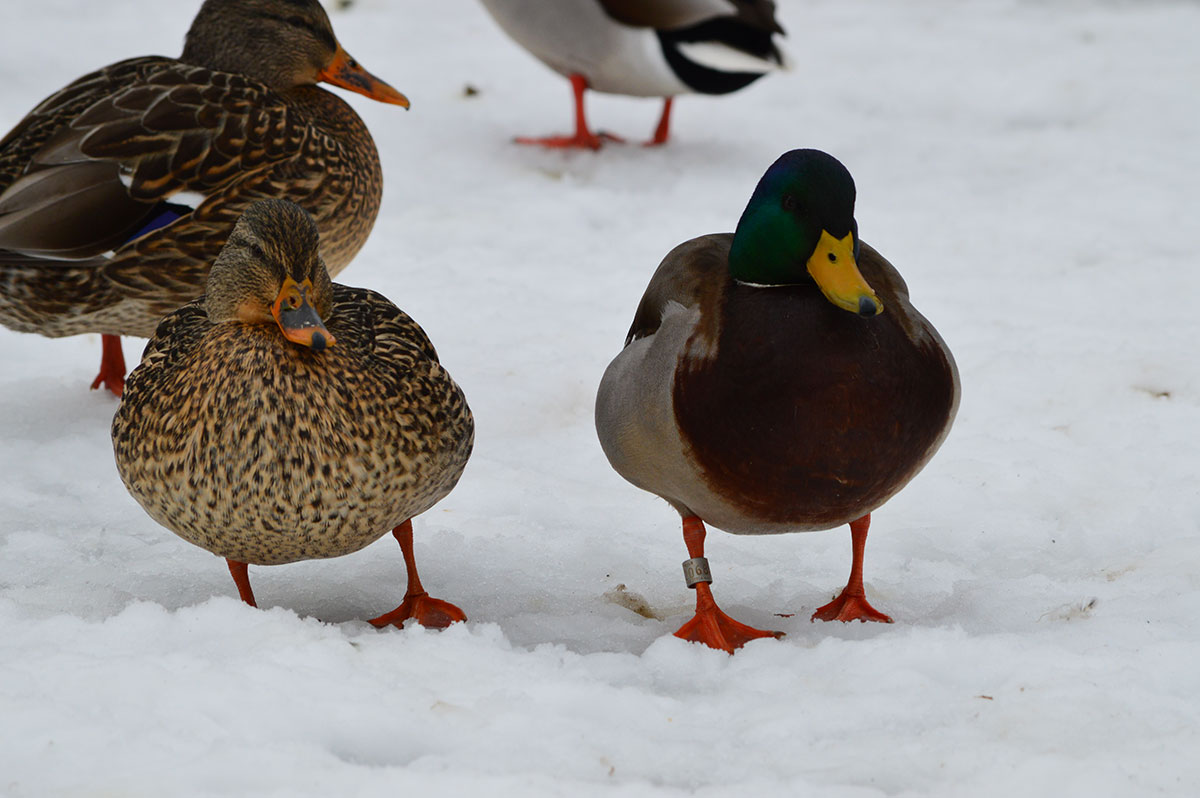Banding Ducks in the Dakotas

Photo: Justin Skrzynski
By Jennifer Kross, Great Plains Regional Office Communications
You know that feeling: First, the thrill of sending your dog to retrieve a duck that has just fallen from the sky. Then, the feeling of anticipation: Will this duck have a band?
Hunters covet these rings like small trophies, symbols of their duck-hunting prowess. But waterfowl bands provide valuable information to scientists about duck populations, survival, migration routes, hunter harvest rates and winter and nest-site fidelity. Results from banding studies support national and international conservation programs such as the North American Waterfowl Management Plan. Since Dr. Paul Bartsch started banding birds in 1902, the tiny aluminum bands have been providing information about migratory birds and helping biologists identify habitats that provide for these birds throughout their life cycle.
DU's efforts
For nine years Ducks Unlimited has been banding ducks at the Goebel Ranch in South Dakota, and for 14 years at sites throughout North Dakota. This year, another crew of banding technicians is setting out with hundreds of small aluminum bands to set traps, catch ducks and send them off with new jewelry. The North Dakota crews are being led by Rick Warhurst, DU manager of conservation programs for the Dakotas. Each year, banding operations start in early August and run until the end of September. This year's North Dakota banding teams were deployed to Lake Ilo National Wildlife Refuge in Dunn County, the Audubon Wetland Management District in McLean and Ward counties and DU's Coteau Ranch in Sheridan County.
"North Dakota has received a lot of moisture this summer," Warhurst said. "Given the great wetland conditions, we will have plenty of wetlands to choose from for trapping sites."
Another crew at DU's Goebel Ranch, led by Randy Meidinger, DU manager of conservation programs in South Dakota, is gearing up for what looks to be a good banding season. "It was a good year for duck nesting on Goebel, and hopefully that will equate to a large number of young birds in our traps this season," said Meidinger.
How do technicians trap ducks for banding?
The traps used to capture ducks for banding are a curiosity for local landowners who wonder how the ducks end up in them. The traps are built from utility fencing bent into a cloverleaf shape. Where the ends of the fence come together, there is a funnel that lets the ducks swim into the trap but prevents them from swimming out. Technicians secure the trap using rebar stakes in a wetland with a water depth of about two feet. Netting is secured over the top and the trap is baited, usually with barley or corn. The traps sit overnight and the technicians return the next day to gather the birds and start banding.
Where are the ducks going?
A wide variety of ducks are banded, with the majority being blue-winged teal. These small ducks travel some of the greatest distances from nesting to wintering grounds. A few of the blue-winged teal that were banded at Goebel Ranch were recovered in Columbia and Venezuela. In 2009, the Goebel crew banded 3,939 of the 14,342 ducks banded by DU in North Dakota.
"This banding season we have already recaptured an unusually high number of female lesser scaup that were originally banded at Goebel," Meidinger said. "Two of the female scaup were banded there in 2009 and another two in 2005. It looks like these girls like to call Goebel home for at least the spring and summer months."
"We have learned a lot about the distribution of birds that we banded in North Dakota," Warhurst said. "Ducks banded here have been recovered in all four North American flyways, but they are primarily using the Central and Mississippi flyways."
How banding information is used
By linking banding sites to the flyways the birds are using, biologists can effectively set harvest regulations in each flyway. They know the status of a population in a certain area and can predict where these birds will go in the fall. In North Dakota, ducks banded on the east side of the state generally use the Mississippi Flyway. Those banded farther west in the Coteau Ranch region use both flyways, with mallards typically going east to the Mississippi and blue-winged teal sticking to the Central Flyway.
"We are trying to determine where the birds we have been banding at Audubon NWR and throughout the wetland management district are going," Warhurst said. "In previous years we banded on the refuge and to the east; this year we are banding on the western areas of the district. We will need to wait a little while before we see the distribution of these birds and if they are focusing on one flyway or the other."
If you have recovered a bird band (duck or otherwise) you can report the number to the U.S. Geological Survey Bird Banding Laboratory. They have an easy-to-use website, www.reportband.gov, where you can enter information about the band, or you can call 1-800-327-BAND (2263). You will receive a report on where the bird was banded and its age. Plus, you get to keep the band for your lanyard!
